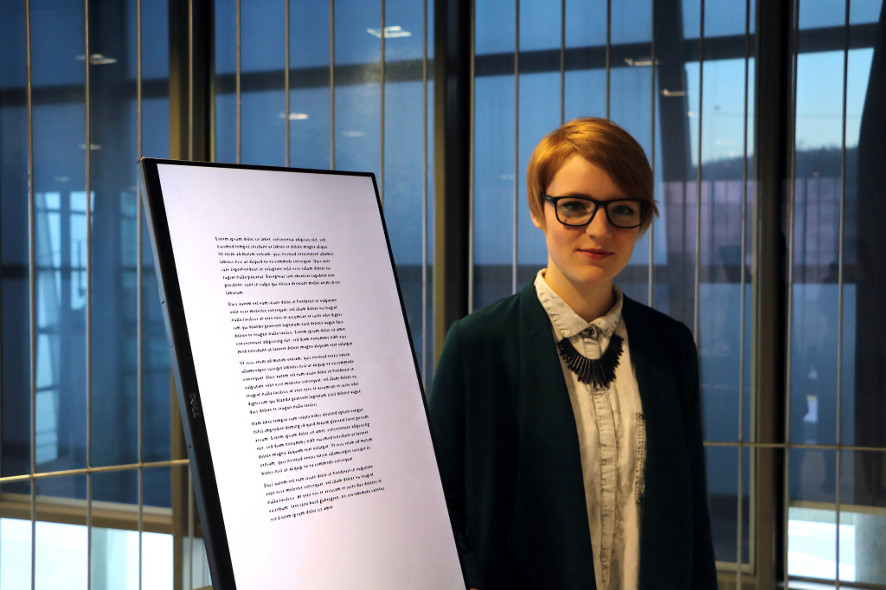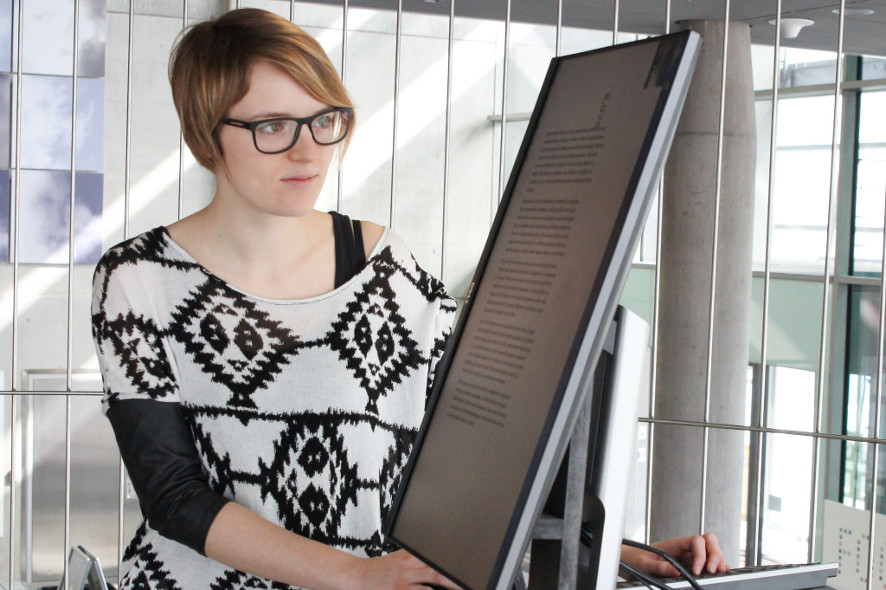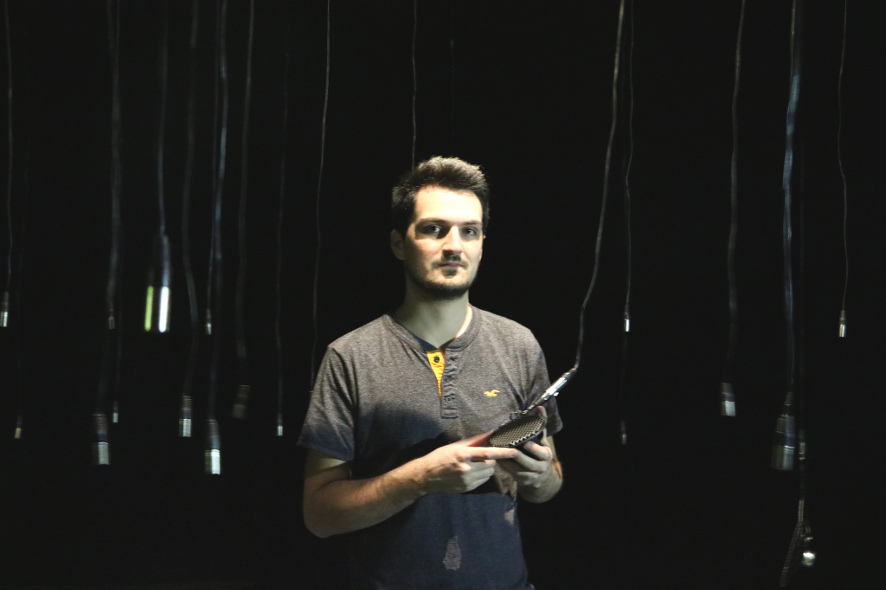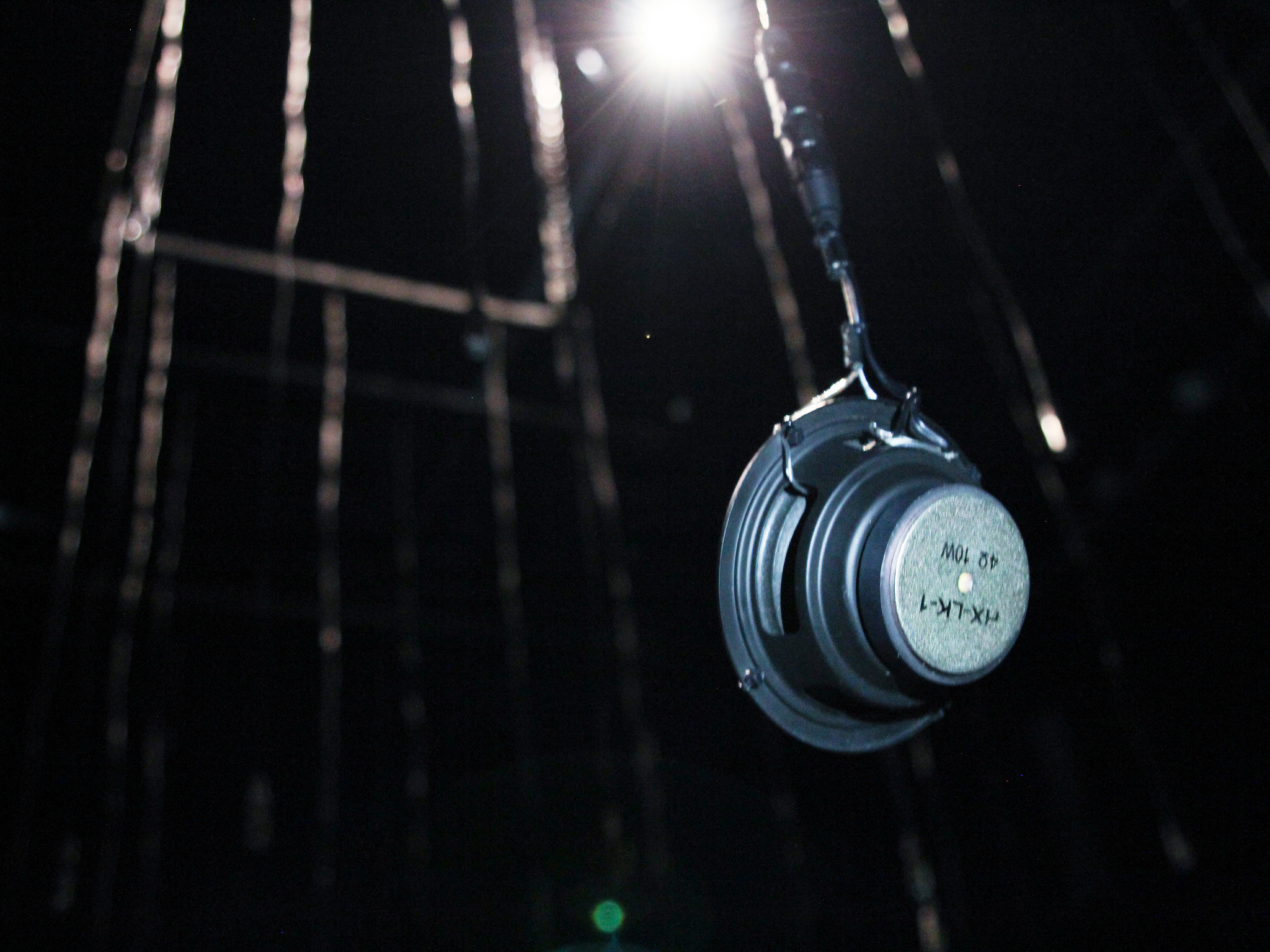This fifth installment in the TIME OUT series once again provides visitors to the Ars Electronica Center with a chance to see outstanding works by students in the Time-based and Interactive Media program at Linz Art University. The exhibition was curated by program director Gerhard Funk, and Gerfried Stocker, artistic director of Ars Electronica. They selected four students, who set up their respective works themselves in the Ars Electronica Center and then presented them at the exhibition opening on March 16th.
We’ve already reported on the ceramic pour printing process developed by Thomas Schwarz, as well as Benedikt Reiter’s “[inter]national coverage.” In this interview, Elisabeth Prast and Fabian Erblehner elaborate on their works.
Elisabeth Prast’s installation entitled “[un]readable” consists of a monitor displaying a text, but regardless of how near the prospective reader gets to the screen, the text remains illegible. If you’re too far away, you can’t make out the writing; when you come closer to the monitor, the letters start to deform and become blurred; and as soon as you take a few steps back again, the words return to their original form. This installation is the artist’s take on the immanent vagueness of our language and communication. We asked her to go into detail about this.

Credit: Magdalena Leitner
Hey Elisabeth! Your installation “[un]readable” addresses the ambiguity of our language and communication. Could you make this clearer for us?
Elisabeth Prast: Whenever information is conveyed, it’s unavoidable that some of it is lost or modified. For instance, this can happen in a conversation and the result can be a sudden misunderstanding. Such shifts in significance become blatant in the process of translation, whereby a word and its literal equivalent in another language can have completely different figurative meanings. And individuals have totally dissimilar levels of knowledge and memories. When I say the word “house,” no two people conjure up an identical image of a house. Basically, communication is an ongoing process of people talking at cross purposes. Often, we try to formulate a thought in words, but the more we try the more everything becomes blurred. This feeling of vagueness is what I want to get across in the installation.
How does this function technically—that the text becomes blurred as soon as you get close to it and returns to its original form when you step back?
Elisabeth Prast: Beneath the monitor, I mounted a camera that captures the position of visitors in the installation space. The person closest to the screen influences the way the text is displayed.
Is there some way to fool the installation so you can read the text despite the technology?
Elisabeth Prast: If you remain stationary, the text automatically returns to its original form after a while. But as soon as you make the slightest movement, the camera captures it and the text becomes illegible again. But even if you could read it, it won’t make any sense—it’s just the familiar filler text beginning with the words Lorem Ipsum.

Credit: Martin Hieslmair
Why did you decide on this filler text?
Elisabeth Prast: This Lorem Ipsum gibberish is used, for example, in graphic design when the final wording of a text hasn’t been settled yet but there’s a need to see what the copy looks like. There’s no meaning; it just looks like a normal text from a distance. There’s a theory that this is a 15th-century Latin text, the letters of which have been scrambled since one sentence corresponds in both texts. So, what was once a disquisition “On the ends of good and evil” is now just filler that’s devoid of any meaning whatsoever. Thus, what occurs in every communications process is expressed here by taking it to the extreme.
Is this your first work of media art and are you already planning your next one?
Elisabeth Prast: Yes, this is my first interactive installation. I’m very interested in the theme and the medium, and I’d love to continue working in this direction, but I don’t have any concrete plans yet.

Credit: Magdalena Leitner
Fabian Erblehner’s work “Plug-it” in an environmental sound installation in which visitors amidst a hanging garden of cables are called upon to create their own soundscape, which is easily accomplished by hooking up cables to loudspeakers. We recently had a chance to chat with him too.
Hello Fabian! The setup of your sound installation “Plug-it” looks complicated. What exactly does this work consist of?
Fabian Erblehner: It consists of three wooden frames, the largest of which measures 3×3 meters. Besides that, I’ve used over 300 meters of cable, 100 connector jacks, five amplifiers, five loudspeakers and countless soldered connections.
What can visitors do with all these jacks, cables and speakers?
Fabian Erblehner: Reconnecting the speakers to the 50 dangling cables enables you to explore a series of atmospheric sound recordings and combine them any way you like. Plus, the installation’s quadratic configuration imparts a spatial impression to the whole setup that resembles a movie theater.

Credit: Magdalena Leitner
That sounds highly technical. How did you acquire the skills to create such an installation?
Fabian Erblehner: Before I enrolled at Linz Art University, I worked for six years as a technician at the Landestheater here in Linz, so that’s where I got my background in sound engineering, electronics and mechanical techniques. But even before I received my training, I was highly interested in technology and I loved to experiment.
Visitors can create their own soundscape. What sounds can you hear?
Fabian Erblehner: Recordings I made in and around Linz—for instance, everyday street noise, a passing trolley car, bicycle bells, the drone of expressway traffic. But there are also the sounds of nature and lots more.
What inspired you to create this installation?
Fabian Erblehner: I can’t say that anything specific really inspired me. It’s simply that I like to work with ambient acoustic influences and combine them with techniques and implementation concepts that are floating around in my head. My second semester project also deals with these phenomena but on a cinematic level.
The opening of TIME OUT .05 was on March 16, 2016. Students’ works can be visited anytime during the museum opening times.
